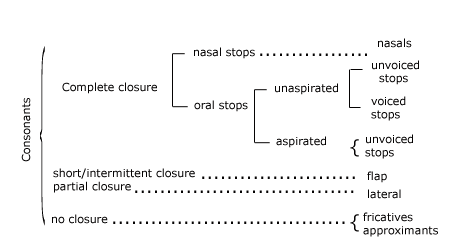puff of
air is absent are known as unaspirated consonants. And as far as
this language is concerned, only the unvoiced stops show a two way
opposition in aspiration, i.e., the unvoiced stops have a set of
aspirated and another set of unaspirated series. Thus as far as the
stops in this language are concerned, they show a total of three
subtypes, viz., (i) unvoiced unaspirated stops, (ii) voiced
unaspirated stops and unvoiced aspirated stops.
Another set of consonants, viz., the consonants in whose
production the closure in the oral cavity is absent may be further
subdivided into two, viz., the consonants in whose production the
closure in the oral cavity is absent but shows the presence of an
audible friction and the consonants in whose production both the
closure and the audible friction are absent. While the former set of
consonants are designated as fricatives the latter set of consonants
are designated as approximants. The total opposition in the manner
of articulation available with the consonants in this language is
represented schematically as under :
|
|
 |
| The
manner of articulation intersects with the points of articulation in
that most of the consonants that are sub-grouped under different
manners of articulation can be further diffentiated on the basis of
the pointed/places of articulation. As far as this language is
concerned, four points of articulation are set up.1
These are: bilabial, dental, palatal and velar. Only the stops,
however, occur in all the four positions. The nasals show only a
three-occur in all the four positions. The nasals show only a
three-way opposition, viz., bilabial, dental and velar positions. The
fricatives also show a three-way opposition in the place of
articulation, but at the dental, palatal and velar positions. The
approximents show only a two-way opposition, viz., bilabial and
palatal and finally the flap and the lateral have only member each,
occurring at the
1Please see item 2 in Appendix 2 for the
justification for the setting up of different consonantal phonemes.
|
dental
position. Thus on the basis of the interaction of the manner and
place of articulation a total of 22 consonantal phonemes can be set
up in this language. These consonants are set up on the basis of the
opposition available in both the word-initial and word-medial
positions. In the absence of minimal, pairs, sub-minimal pairs are
given for both these positions.
|
Opposition in the word
initial position :
|
| pora |
tora |
cor |
korone |
| ‘from’ |
‘star’ |
‘thief’ |
‘for’ |
| borol |
dorja |
jorawa |
gor |
| ‘wap’ |
‘door’ |
‘joint’ |
‘rhinoceros’ |
| phor |
thapor |
charijaba |
khor |
| ‘grass hopper’ |
‘slap’ |
‘to leave’ |
‘ring worm’ |
| mora |
nor m m |
|
|
| ‘dead’ |
‘soft’ |
|
|
|
lori daughter’ |
|
|
|
roti ‘bread’ |
|
|
|
soray
‘bird’ |
or m
‘shame’ m
‘shame’
yud
‘war’ |
horu
‘little’
|
| wul
‘wool’ |
|
|
|
|
|
|
|
|
|
Opposition in the word
initial position: |
|
 puni
‘you’
ata ‘wheat puni
‘you’
ata ‘wheat  car
‘pickle’ car
‘pickle’  ko
‘again’ ko
‘again’ |
|
 b b ‘grand mother adua ‘ginger’
‘grand mother adua ‘ginger’
 ji
‘today’ ji
‘today’  gote
‘in front of’ gote
‘in front of’ |
|
|
|
liphapha
‘envelope’ atha
‘gum’ onchal
‘area’ khapathawa
‘send’ |
|
 ma
‘mother’ ma
‘mother’  niba
‘to
bring niba
‘to
bring   ur
‘grape’ ur
‘grape’ |
|
 r r 'and'
'and' |
|
 l l k 'seperate' k 'seperate' |
|
bisa ‘cater-bias
‘faith’ j has
‘ship has
‘ship |
|
pillar |
|
bikhawa ‘pain’ beya ‘bad’ |
For ease of description, it
is proposed to take up the discussion of each of the phoneme classes
available in this language one by one. In this we begin with the
stops.
|
|
Stops including the
affricates:
|
Phonetically, the affricates
are produced differently from that of the steps. In the production
of the stops, the complete closure is released suddenly with a
poison, whereas in the production of the affricates, the closure is
released gradually immediately after the part of the tongue makes
contact with one of the places of articulation.
|